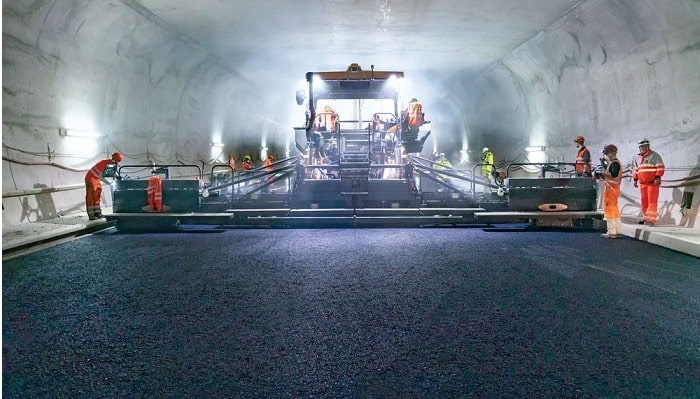With a roadway restoration project on the Schiedhaldensteig road, the Swiss municipality of Küsnacht has gone beyond the concept of connected building.
The entire project, from the initial surveying to the remodelling of the road and pedestrian surfaces as well as the supporting services, down to the final as-built surveying, was offered as an all-digital Design and Build prototype project. This includes pipelines for drainage, gas, water, and electricity. The goal was to figure out how to effectively build the groundwork for an entirely digital, data-driven approach to road maintenance in the future.
The winning bidder was the Swiss division of Austrian construction behemoth Strabag, which created a workflow that was almost entirely based on Trimble technology. The contractor collaborated with the local Swiss Trimble Geospatial solutions company ALLNAV as well as the Trimble distributor MEB Group, which is the parent company of SITECH and BuildingPoint Switzerland, two companies that specialise in construction technology.
According to Stijepan Ljubicic, BIM Technical Group Leader at Strabag, Küsnacht wanted to have a thorough grasp of the opportunities to reduce lifecycle costs on infrastructure maintenance projects. Their customer was keen on getting the most cutting-edge technology solution for the project. Because of this, just 40% of the final contract award was based on pricing. They were given the chance to introduce what they like to refer to as our 5D approach, with digital delivery accounting for 30% of the total.
In this method, time is added to the standard 3D modelling as the fourth aspect and process data as the fifth. To support long-term maintenance planning, visualisation, quality assurance, and control, the process data also incorporates cost and lifetime data.
For Networked Construction, Use BIM
A cloud-based Common Data Environment (CDE) built on Trimble Connect was used as the open collaboration mechanism for getting data to and from other systems, enabling the 5D Field2BIM2Field setup.
The 3D design model created in ProVi might input data via Trimble Connect to Trimble Quadri since all solutions adhere to the IFC standard. Through Trimble Connect, as-built data created in the field was also transmitted back to ProVi.
The GIS-referenced BIM model served as the foundation for all aspects of the project, including the estimating, computation, and planning of the necessary labour hours and materials up to the final settlement. During the project’s groundwork phases, the model transmitted 3D data via Trimble WorksManager to the survey crew using its Trimble Siteworks Positioning System and to the excavator using its Trimble Earthworks 3D Grade Control Platform.
The Trimble Business Center handled both the as-built documentation and design data (DTM) preparation for machine operation. In the meantime, Trimble WorksManager served as the information hub, tying together the field systems to provide precise real-time status information on the positions of equipment and design revisions.
Operators could view the most recent 3D model overlaid onto the surface on the Trimble Earthworks Grade Control Platform screens in the machines, seeing cut/fill information, slope data, and other bench points and points of reference in context. Since everyone used the same BIM model, there was no need for any further work.
The new road’s surface was paved in the same manner. Both the compactors and the pavers received information on the necessary design. This resulted in an efficient compression procedure and a smooth road with good ridability. The compactors helped ensure that the work was done according to plan and that the proper information was included in the final as-built model by taking note of pass counts, the intensity of compaction, and the surface temperature. Surveyors utilising both Trimble GNSS receivers with tablets and a total station with a data collector continuously monitored quality and progress in the field in a Field2BIM setup.
Maps On Mobile Devices
To wrap up the project, Strabag employed its Trimble MX9 mobile mapping system to capture the Schiedhaldensteig road’s as-built scenario. The Küsnacht municipality now has a completely exact digital twin of this section of road, which they will utilise for operation and maintenance.
All parties involved learned a lot from this, according to Ljubicic. For the utility company employees who at first were concerned about working without paper drawings; for the excavator operators who had to completely rely on technology rather than getting out of the cabin to measure points, and for the municipality officials who closely monitored the project via weekly as-built model compilations.
Partnership and transparency, he continued, were really the essential words on this initiative. Throughout the construction process, all of the pertinent information was always available to all parties. Even the locals may browse a dedicated website with a QR code to acquire an up-to-date progress report of the construction projects and learn what to anticipate in terms of disruption from work being done in their neighbourhood. This 5D BIM methodology provides 360-degree vision in reality.


































